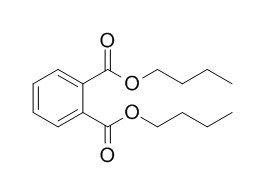1,2-Benzenedicarboxylic acid
1,2-Benzenedicarboxylic acid is one kind of allelochemical shows stronger allelopathic effect on itself than on wheat and pigeonpea. 1,2-Benzenedicarboxylic acid has antimicrobial activity, it shows anti-extended-spectrum beta-lactamases (ESBL) activity.
Inquire / Order:
manager@chemfaces.com
Technical Inquiries:
service@chemfaces.com
Tel:
+86-27-84237783
Fax:
+86-27-84254680
Address:
1 Building, No. 83, CheCheng Rd., Wuhan Economic and Technological Development Zone, Wuhan, Hubei 430056, PRC
Providing storage is as stated on the product vial and the vial is kept tightly sealed, the product can be stored for up to
24 months(2-8C).
Wherever possible, you should prepare and use solutions on the same day. However, if you need to make up stock solutions in advance, we recommend that you store the solution as aliquots in tightly sealed vials at -20C. Generally, these will be useable for up to two weeks. Before use, and prior to opening the vial we recommend that you allow your product to equilibrate to room temperature for at least 1 hour.
Need more advice on solubility, usage and handling? Please email to: service@chemfaces.com
The packaging of the product may have turned upside down during transportation, resulting in the natural compounds adhering to the neck or cap of the vial. take the vial out of its packaging and gently shake to let the compounds fall to the bottom of the vial. for liquid products, centrifuge at 200-500 RPM to gather the liquid at the bottom of the vial. try to avoid loss or contamination during handling.
Metabolites2023, 13(1), 3.
Analytical Letters 2021, 54(4).
Int J Vitam Nutr Res.2022, doi: 10.1024.
Cell Death Discov.2023, 9(1):350.
Heliyon.2022, 8(12):e12031.
Molecules.2024, 29(5):1171.
Molecules.2023, 28(8):3291.
Sci Rep.2024, 14(1):28864.
Appl. Sci.2022, 12(4), 2032.
Foods.2023, 12(6):1130.
Related and Featured Products
Basic Research Journal of Microbiology, 2016 June, 3(2): 08-11.
Antimicrobial activity of 1,2-benzenedicarboxylic acid, butyldecyl ester isolated from the seeds and pods of Acacia nilotica Linn[Reference:
WebLink]
The antimicrobial activity of 1,2-Benzenedicarboxylic acid, butyldecyl ester isolated from Acacia nilotica was determined using standard methods.
METHODS AND RESULTS:
The compound was isolated by directing the fractionation of ethyl acetate extract of the air dried seeds and pod with microbial sensitivity test. The results of the antibacterial screening showed that the ethyl acetate extract of Acacia nilotica Linn exhibited the highest activities against the test microbes with zones of inhibition diameter ranging from 27-32mm against Salmonela typhi, Escherichia coli, Streptococcus feacalis, Staphylococcus aureus, Candida krusei and Shigella dysentriae.
CONCLUSIONS:
The structure of the compound was identified from 13CNMR, 1HNMR, IR and GC-MS spectral data. The isolation, structural elucidation, NMR spectral assignment and bioactivities are reported.
International Journal of Pharma & Bio Sciences, 2015 , 6 (1) :1190-1195.
In-Silico Analysis of Streptomyces sp secondary metabolite 1,2-Benzenedicarboxylic acid, mono (2-ethylhexyl) Ester with ESBL proteins[Reference:
WebLink]
The anti-ESBL activity of 1,2-Benzenedicarboxylic acid, mono (2-ethylhexyl) ester (DMEHE) extracted from marine Streptomyces sp strain VITSJK8 was further confirmed by in silico analysis.
METHODS AND RESULTS:
A total of 10 ESBL proteins was chosen for this study from the protein data bank (PDB) and were docked with the DMEHE. The resultant atomic contact energy (ACE) was compared with dockings of known antibiotic ertapenem, penicillin G, amoxicillin, rocephin and cefozopran. PatchDock online docking server was utilized for docking studies. LigPlot+ and PyMOL were used to evaluate the docking results obtained from PatchDock. The docking of DMEHE with ESBL proteins showed the ACE value range from -198.42 to 22.62, while docking of ertapenem showed the ACE value range from -217.67 to -71.8. DMEHE formed hydrogen bonds with AMPC, CTXM-9, TEM-1 and TEM-52 ESBL proteins. The interaction between DMEHE and ESBL protein complex was unstable and no covalent bond formation was observed, whereas ertapenem and ESBL complex was highly stable because of the covalent bond and hydrogen bond formation in the ligand-protein interaction. Similarly penicillin G, amoxicillin, rocephin and cefozopran also demonstrated higher stability with ESBL proteins compared to DMEHE.
CONCLUSIONS:
Based on this study, it could be concluded that bacterial proteins will not involve in lysis of DMEHE and therefore DMEHE would be an effective drug for treating the drug resistant ESBL pathogens.
Journal of Gansu Agricultural University, 2007, 42(5):43-48.
Identification of root exudation of Zea mays L. and allelopathy of 1,2-benzenedicarboxylic acid[Reference:
WebLink]
Root exudation is one of the most important resources of allelochemical.
METHODS AND RESULTS:
In this study,the root exudation of Zea mays L.seedlings,which were cultivated in liquid,was extracted with C2Cl2 35 d ays after germination,and was identified by the way of gas chromatographymass spectrometry(GC-MS).At the same time,the biological characteristics of the typical exudation 1,2-Benzenedicarboxylic acid was tested through germination experiment.
CONCLUSIONS:
The results indicated that the component of the exudation mainly included hydrocarbon,benzene,thiazole,organic acid,ketone,amide,grease,mellow and phenol etc.The typical exudation 1,2-Benzenedicarboxylic acid as one kind of allelochemical showed stronger allelopathic effect on itself than on wheat and pigeonpea.



